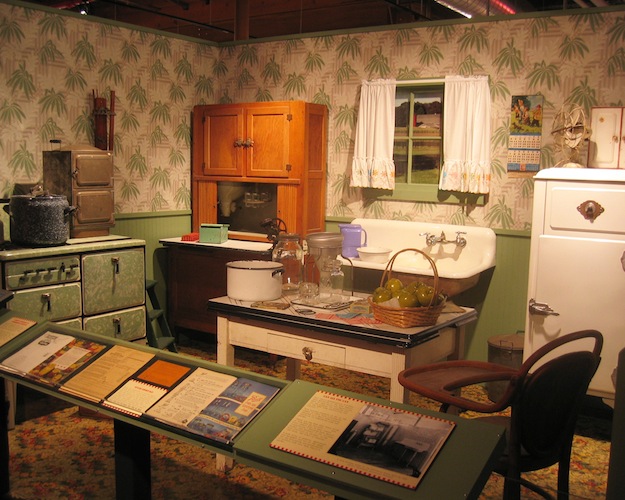Food Feature: The Culinary Arts Museum — A Mouth-Watering Experience
The Culinary Arts Museum at Johnson & Wales University reopened in September after a fifteen month hiatus to re-assess its inventory.
By Kathleen C. Stone
We tend to look at history through a lens, choosing to filter the past through the perspective of political movements or military events, social issues or cultural fashions. In the Culinary Arts Museum at Johnson & Wales University in Providence, Rhode Island, the prism, not surprisingly, is food, and that, together with the inevitable add-ons of hospitality and travel, ends up illuminating the American experience in fascinating ways.
The museum reopened in September after a fifteen month hiatus to re-assess its inventory, a much needed reboot given that the number of donations had accumulated over the years, including sixteen trailers’ worth of material from Louis Szathmary, former owner of The Bakery in Chicago and chef laureate at Johnson & Wales. Little has changed in the public exhibits, but now the museum knows in much more detail what sits in its 10,000 square foot storage area.
On a recent visit, I met Richard Gutman, the museum’s Director and Curator, and a renowned expert on a unique American eating experience – the diner. A good part of the museum’s floor space is devoted to displaying diner memorabilia, including a neon sign from Moody’s in Waldoboro, Maine, a lunch counter from Providence’s own Ever Ready Diner, as well as furniture, tableware, models, menus, and photographs from myriad diners. The objects tell a very American story, or at least a fat slice of it, providing insights into economic cycles, manufacturing ups-and-downs, evolving architectural styles, the impact of immigration, changing tastes, and the effects of a more mobile population.
Even before there were diners, as far back as 1872, horse-drawn food carts served simple food to night-time workers, early forerunners of today’s food trucks. The carts soon evolved into larger structures where customers could sit down and diners were born. Their popularity soared until their heyday in the 1920s and ‘30s, when the diners took on that classic streamlined look, with lots of stainless steel, enamel and glass block. Diners continued to spread across the country until the Great Depression put the brakes on. The Second World War, generating metal and manpower shortages, all but stopped construction. By the late ’40s, though, more companies were building diners than ever before. Post-war diners were larger and more diversified in appearance (futuristic and Mediterranean styles became popular), and they offered wider selections of food, particularly Greek specialties. But with the boom came serious competition, hamburger chains such as MacDonald’s taking away market share. Diners began to struggle: the Worcester Lunch Car Company, which had produced more than 600 diners in the first half of the century, closed its doors in 1957.
There is more to the American culinary story than diners, of course, and another exhibit explores the story of food in the White House. Several walls display letters and artifacts from throughout Presidential history, including an ad for a chef George Washington placed – even before there was a White House – in the help wanted section of a New York newspaper. There’s Presidential correspondence past and present about food and drink, including records of who dined with this or that leader, what they were served, and how presidents (or their secretaries) wrote to friends and supporters about the experience of breaking bread together.
The museum also features a tavern from the 1830s, a 1940s kitchen, paraphernalia for cooking outdoors, and diverse kitchen equipment ranging from hearth hoes of the colonial era to early microwave ovens.
Now that the inventory is complete, the Culinary Arts Museum has plans for a number of temporary shows. The opportunities for public exhibits and scholarship are tantalizing. Take, for example, the 60,000 volumes of print material, about half of them cookbooks. Add to that thousands of food-related and ethnographic objects, images, and other archival material and you have the makings of a paradise for cultural historians and serious foodies.
One intriguing example from the archive which Gutman showed me on his computer (it is not currently on view) is a ’30s menu from the Southern Pacific rail line offering travelers an all-you-can-eat salad bowl for 25 cents, with fresh lettuces and vegetables picked from agricultural land owned by the railroad—an early spin on the farm-to-table model so popular today. Pictured on the menu is a Pullman porter, dark skinned in a white coat, serving salad to a well-dressed white couple — a discomforting slice of American history and culture.
The museum is and will remain a teaching institution, with a prominent role in Johnson & Wales’s curriculum, which includes engineering and design, business, food service management and, of course, culinary arts. Student work is therefore also on display, including spectacular wedding cakes, ornate chocolate creations and other confections. I was introduced to Harry, a second-year student who had created a colorful underwater scene from sugar, using specially designed molds and hand piping. In the display case, his sugary fish, sea urchins and foamy wave, air brushed to a smooth finish, looked like brightly pigmented glass.
This museum generates a tremendous sense of fun. Foodies, of course, will enjoy it, and if your timing is right, you can combine your visit with lunch at a nearby diner or bakery—the museum hands out a list of recommended options. But for those interested in cultural history, the place intrigues not only for what is on display but for its educational potential. The next installation, scheduled to open March 3, 2015, will explore past efforts to combat hunger.
Kathleen C. Stone is a writer pursuing her MFA degree, a lawyer who earned her JD many years ago, and a student of art history even before that. Her blog can be found here.
Tagged: Culinary Arts Museum, Johnson & Wales University, Kathleen C. Stone


